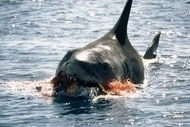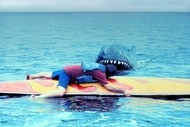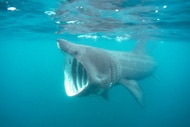Create a free profile to get unlimited access to exclusive videos, sweepstakes, and more!
Swimmer Seriously Injured in South California Shark Attack
Surrounding beaches are temporarily closed following the incident.

A 46-year-old man swimming at a South California beach was seriously injured during a shark attack yesterday.
The swimmer was about 100 yards from the shore with a group of about a dozen other swimmers, when the attack occurred at approximately 9:00 A.M. The group regularly meets for early morning swimming sessions and they jumped into swift action, pulling the victim to shore where a lifeguard applied a tourniquet to slow the bleeding. The victim was taken to Scripps Memorial Hospital La Jolla, via Deadline.
A hospital spokesperson couldn’t confirm the man’s condition but city officials described his injuries as significant but not life threatening, reports The San Diego Union-Tribune. Local lifeguards closed the beach a mile north and south of the incident through 9:00 A.M. Tuesday, June 4, as a precaution.
For More on Sharks:
How Baby Hammerheads Grow Their Weird Tool-Shaped Heads
Longest-Living Vertebrate Ever? Greenland Shark Thought to Be 393 Years Old, Give or Take a Century
A South African Killer Whale Took on a Great White Shark One-on-One and Won
Shark Attacks Swimmer at South California Beach
It was an overcast morning with murky waters which may have contributed to the attack conditions. While the attacking shark was not recovered, experts suspect it was a juvenile great white shark, based on the extent of the injuries and tooth spacing. Considering the dark and gloomy water conditions, it’s possible the attack was a case of mistaken identity. Juvenile white sharks are known to frequent the area during the spring and summer months, but they don’t often attack people. In fact, California isn’t really known for shark attacks.
In 2023, there were 16 unprovoked shark attacks in Florida (where the majority of U.S. attacks take place) and only two in California. These rare and often terrifying encounters with nature make headlines as easily as they make summer blockbusters, but your risk of attack is staggeringly low, even if you spend a lot of time in the water. Globally, there are about 100 shark attacks every year, give or take, resulting in about five deaths. The precise numbers aren’t known because not all attacks are reported, but that gets us in the ballpark.
It’s true that the raw number of attacks is on the rise, but that’s largely a function of more people being in the water, not an actual increase in individual risk. If you want to reduce your already low probability of being bitten by a shark, there are a few things you could do (or avoid). Most shark attacks happen near the shore in relatively shallow water. Sharks feed in the shallows and can get stuck there during low tide. Most attacks (42%) are associated with surfing or other board sports while swimming and wading takes a close second at 39%. A much smaller portion of attacks occur during snorkeling and other water activities.
If you are bitten, the odds are you’ll walk (or wade) away from it. Most attacks are hit and runs, the result of mistaken identity. A shark swoops in for a nibble, realizes you aren’t food, and dips. Bump and bite attacks, like the one that occurred Sunday morning, often result in more serious injuries. These, along with sneak attacks, often involve multiple and sustained bites. These sorts of attacks are rarer, but typically result in more severe injuries and deaths.
As the weather gets warmer, the beaches start calling, and we’re not the only ones heeding the call. Stay safe out there!
We prefer sharks on screen instead of in person; catch Jaws from Universal Pictures.























